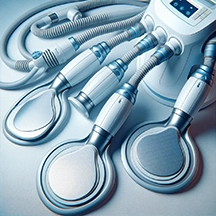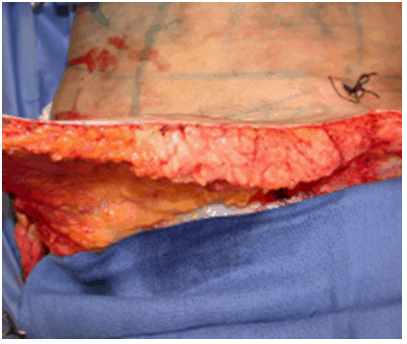Paradoxical Adipose Hyperplasia After Cryolipolysis – Causes, Symptoms, Treatment
Cryolipolysis is a popular non-invasive fat reduction treatment. However, some patients develop a rare complication called paradoxical adipose hyperplasia (PAH) where the fat layer becomes thicker. Understanding the causes, symptoms, and treatment approaches for PAH after cryolipolysis can help guide proper management.
Overview: What is Cryolipolysis?
Cryolipolysis uses controlled cooling to selectively damage fat cells in specific areas of the body. Common treatment sites include the abdomen, flanks, upper arms, inner thighs. An applicator is placed on the skin’s surface to gently cool the underlying fat layer without harming other tissues (Jalian et al., 2021).
The cooled fat cells enter apoptosis, a form of cellular death. Over time, the body’s natural processes gradually eliminate the treated fat cells. Most patients see a noticeable reduction in treatment areas within 2-3 months.
CoolSculpting, a widely marketed non-surgical fat reduction technique, often falls short of expectations for several reasons. In the modern healthcare landscape, numerous physician offices have access to advanced data and technology, including CoolSculpting. However, not all practitioners possess the in-depth knowledge required for effective fat removal, which is crucial for achieving desired outcomes. This lack of expertise can result in unsatisfactory results, as I have observed in my practice.
Dermatologists and various healthcare providers, including family practitioners and even dentists, have begun offering CoolSculpting services. However, their limited understanding of the complexities involved in fat removal and skin texture often leads to suboptimal outcomes. To ensure the best possible results for body contouring, consulting a plastic surgeon with extensive experience in both fat disruption and skin redundancy is imperative.
As a plastic surgeon, I emphasize the importance of understanding both fat and skin for successful body contouring. Even within the field of plastic surgery, not all surgeons are equally skilled in these areas, highlighting the necessity of thorough research and selection of a qualified plastic surgeon.

How CoolSculpting is performed
CoolSculpting operates by using a wand to freeze fat cells in targeted areas of the body. Fat cells, like other living cells, require an adequate body temperature to survive. Freezing causes these cells to die, and the body naturally eliminates them, a process known as Cyrolipolysis (Cryo for cold, lipo for fat, and lysis for cell death). However, this process is gradual, and results may not be visible for 1-3 months. In contrast, VASER Liposuction, which I perform, offers immediate results visible on the same day of the surgery.
Limitations of CoolSculpting
One significant limitation of CoolSculpting is its inability to provide comprehensive body contouring. Unlike High Definition VASER Liposuction 360, which allows for complete body transformation, CoolSculpting is only effective in small, localized regions. It is best suited for patients close to their ideal body weight, typically with a BMI of 25-30. Additionally, the external application of CoolSculpting makes it challenging to accurately gauge the extent of fat removal compared to the more precise technique of liposuction.
In the abdominal region, many patients, particularly post-pregnancy women or those who have experienced significant weight loss, often face issues with CoolSculpting. They are left with redundant skin, as the procedure removes fat but does not address skin laxity. This lack of attention to skin texture and redundancy can lead to a “hood-like” appearance. Moreover, post-pregnancy patients may have weakened abdominal muscles, known as rectus diastasis, which only surgical intervention can repair. Unfortunately, many healthcare providers and patients are not adequately educated about these complexities.
Another issue is the presence of visceral fat, a deep-seated fat that is not effectively removed by either CoolSculpting or even VASER Liposuction. This type of fat, often related to hormonal imbalances like low testosterone, leads to a bloated appearance in the abdominal area. Recognizing and addressing visceral fat is crucial, and often, physical examination reveals a distended abdomen that remains bloated even when trying to suck in. This is a clear indication of visceral fat and another reason why CoolSculpting may not be effective.
Additionally, skin sensitivity in areas such as the neck, arms, and medial thighs poses a challenge for CoolSculpting. In these regions, VASER Liposuction combined with skin tightening techniques like Renuvion J Plasma Tightening is often more appropriate to avoid irregularities and divots in the skin.

What is Paradoxical Adipose Hyperplasia (PAH)?
In a small subset of patients, an unusual complication called paradoxical adipose hyperplasia can occur after cryolipolysis. With PAH, the fat layer regrows thicker and more pronounced several months after treatment (Kelly et al., 2022).
Doctors remain uncertain about what triggers this abnormal tissue reaction. Proposed mechanisms include inflammation, disrupted fat metabolism, and stem cell disturbances. PAH has been reported to occur in 0.2% to 0.7% of cryolipolysis patients (Jalian et al., 2021). However, clinically, it has been observed to be higher in occurrence and associated with moderate weight gain.

What Symptoms Suggest PAH After Cryolipolysis?
Individuals developing PAH after cryolipolysis often notice:
- Initial fat reduction after treatment with gradual regrowth
- Enlargement or thickening of the fat bulges months later
- Asymmetric, irregular contours and indentations
- Hard, firm nodules or masses within the fatty area
- Worse appearance compared to before treatment
- Lack of improvement despite diet and exercise
Seeking prompt medical follow-up for recurrence allows for accurate PAH diagnosis.
What Causes Paradoxical Hyperplasia After Cryolipolysis?

Researchers propose several mechanisms that may instigate paradoxical adipose hyperplasia following cryolipolysis (Kelly et al., 2022):
- Inflammation from fat injury triggers fibrotic scar-like tissue
- Fat stem cell stimulation causes abnormal proliferation
- Hormones like insulin, and growth factors disrupt the regulation
- Genetics may predispose certain individuals
- Interruption of apoptosis allows fat survival (Mowlavi Paper – Need link)
However, the exact causes remain unclear currently. Ongoing studies will further establish risk factors for PAH.
How is PAH After Cryolipolysis Evaluated and Diagnosed?
To accurately diagnose paradoxical adipose hyperplasia, providers combine:
- Medical history review for symptom onset and progression (Krueger et al., 2022)
- Physical examination to feel for firm nodules or tissue thickening
- Ultrasound imaging to characterize the focal fatty deposits
- MRI studies to visualize PAH morphology and size
- Potential biopsy for microscopic analysis in some cases
Correct PAH diagnosis is essential for appropriate treatment management going forward.
What Treatment Options Exist for PAH After Cryolipolysis?
Treating paradoxical adipose hyperplasia often involves:
- Liposuction to remove thickened fatty deposits (Kelly et al., 2022)
- Power-assisted liposuction for dense, fibrotic fat (Sasaki, 2016)
- Laser, ultrasound or water-assisted liposuction techniques(Mowlavi – need link to paper)
- Direct excision of isolated PAH lesions (Krueger et al., 2022)
- Fat grafting for any contours irregularities (Garibyan et al., 2022)
Revision surgery is often successful but can be more difficult than the original cryolipolysis.
Conclusion: Paradoxical Adipose Hyperplasia After Cryolipolysis is an infrequent complication
In conclusion, when considering body transformation, it is crucial to conduct thorough research and consult with a board-certified plastic surgeon, especially if more extensive body contouring is desired. While CoolSculpting may be suitable for patients at or near their ideal body weight seeking to address small areas of localized fat, it has limitations that must be understood and considered.
While paradoxical adipose hyperplasia is an uncommon occurrence after cryolipolysis, being aware of its symptoms and staying in touch with your provider allows for prompt treatment. In most cases, surgical intervention can address PAH effectively and safely. Patients should follow all post-procedure instructions and continue healthy lifestyle habits to help maintain improvements long-term.

